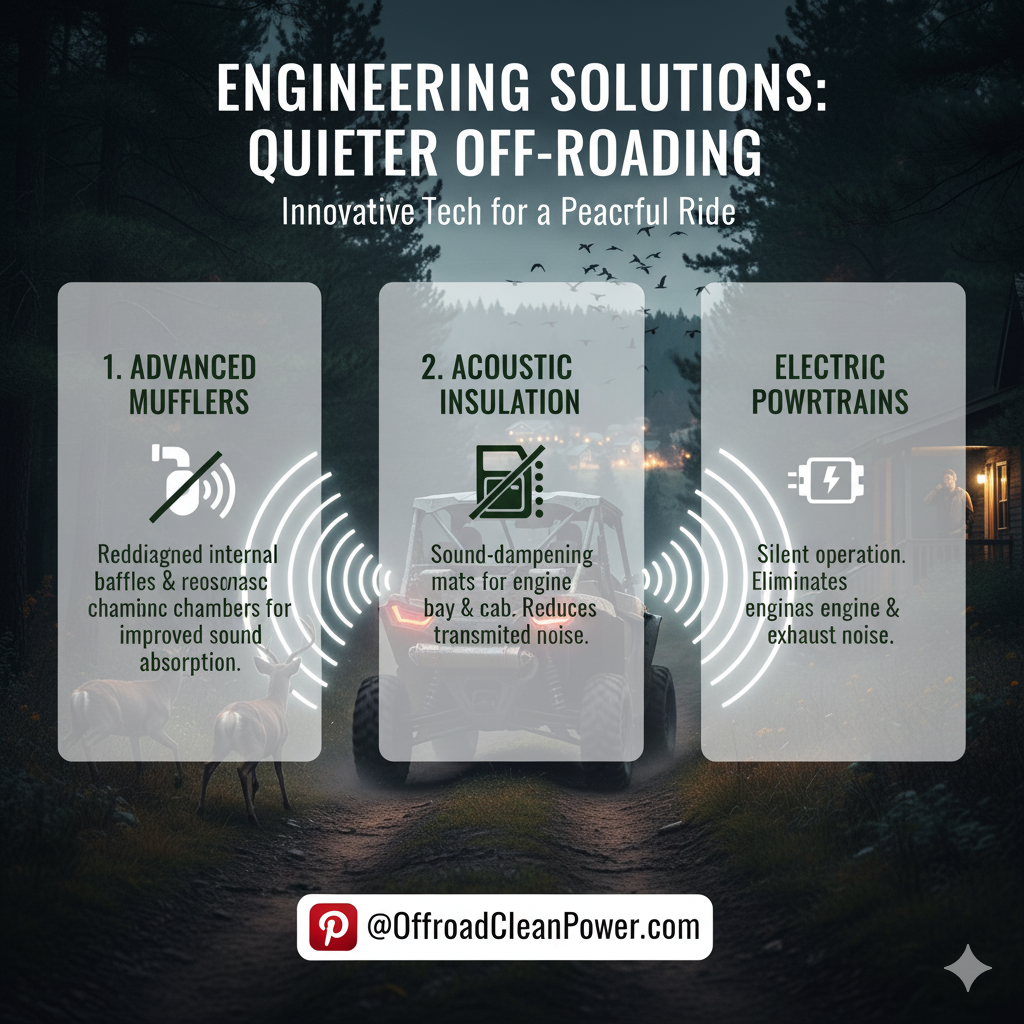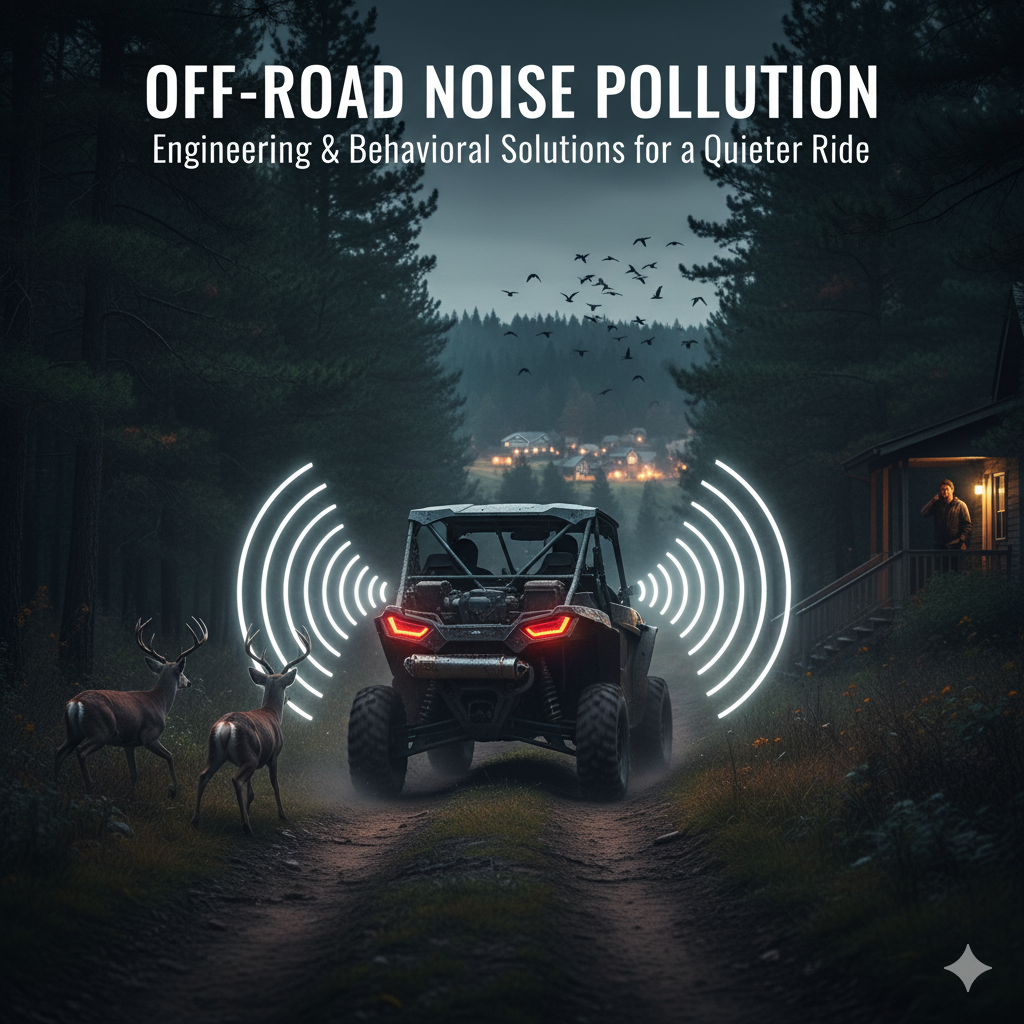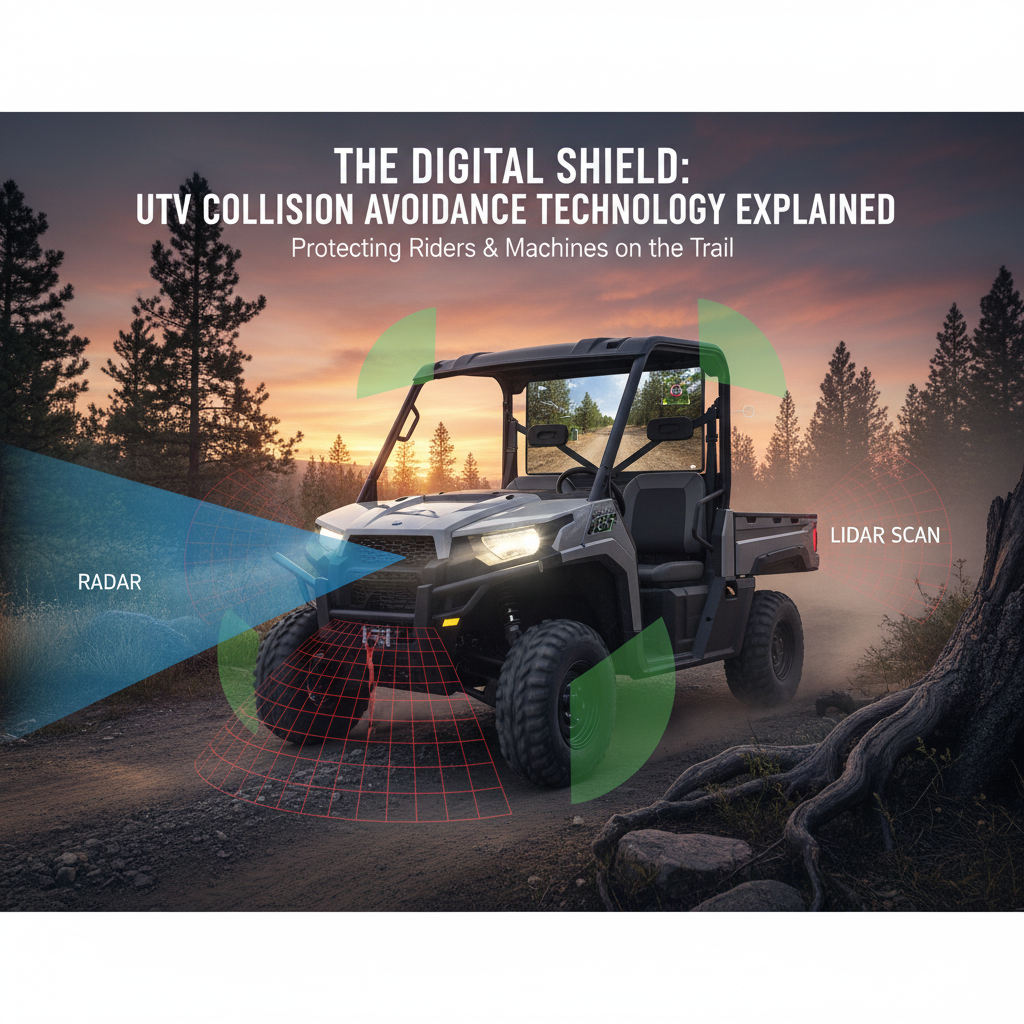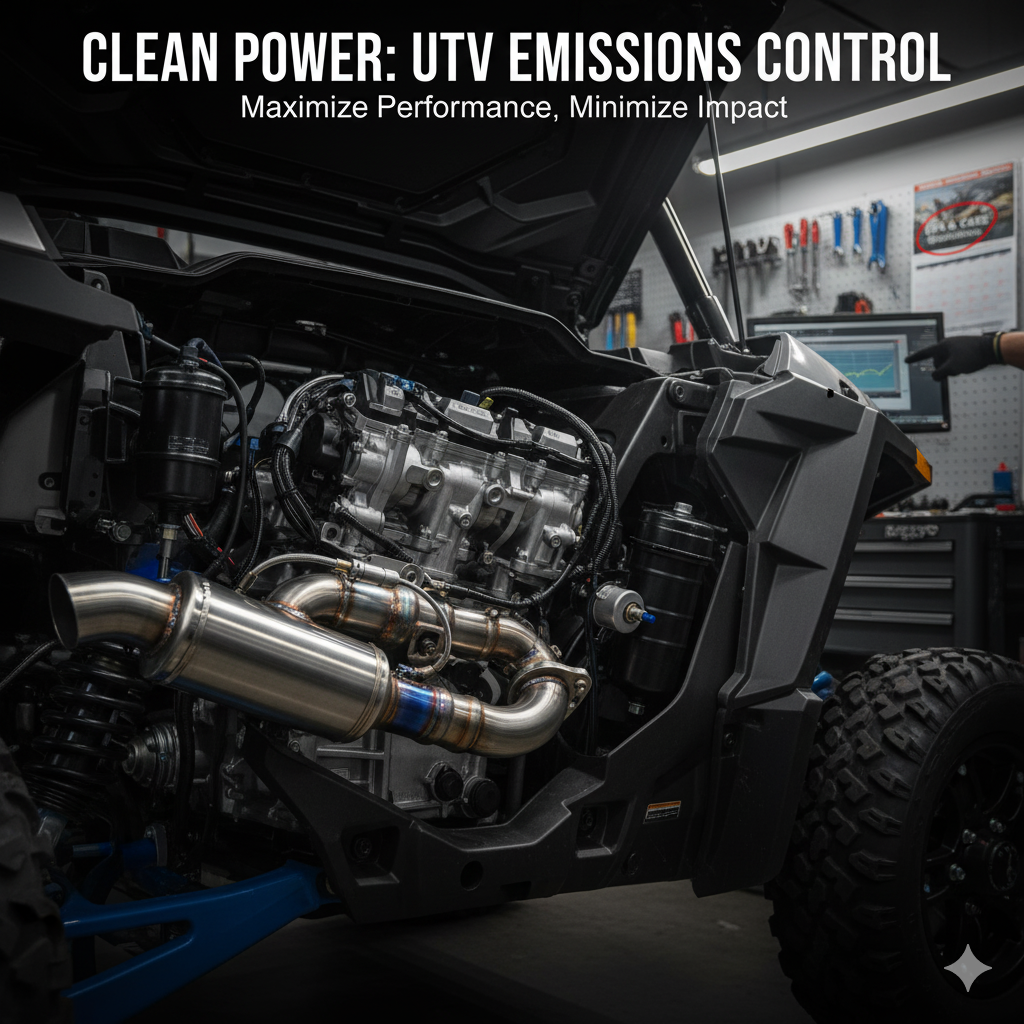The sound of a powerful engine is, for many, an integral part of the off-road experience.
However, that same sound, when uncontrolled, becomes off-road noise pollution, a significant environmental concern that impacts wildlife, disturbs nearby residents, and is a leading cause of trail closures.
The challenge for the UTV industry and community is to reconcile the thrill of the ride with the imperative of acoustic responsibility.
This is a critical balancing act, where engineering innovation meets responsible stewardship to ensure the longevity of off-road access.
The modern UTV enthusiast understands that a quieter trail is a more sustainable and enjoyable trail for everyone.

The Anatomy of UTV Noise: Identifying the Sources
To effectively reduce noise pollution, one must first identify its primary sources, which are often more complex than a simple loud exhaust.
A UTV generates noise from multiple points, which can be broadly categorized into mechanical, aerodynamic, and tire noise, each requiring a distinct mitigation strategy.
The Dominance of Exhaust and Engine Noise
The most dominant and recognizable source of noise is the exhaust system, which is the direct result of the rapid expansion of combustion gases exiting the engine.
This creates a powerful acoustic wave that travels long distances, often irritating residents and disturbing wildlife [1].
Engine noise itself, generated by the internal moving parts, such as the valvetrain and pistons, also contributes significantly, especially in high-performance, high-revving engines.
This is the area where manufacturers have focused the most attention, driven by increasingly stringent regulatory standards from bodies like the EPA and the Forest Service.
The phenomenon of “sound propagation” in open environments means that even a moderate noise level can travel for miles, especially in quiet, remote areas, making the perceived impact far greater than the measured decibel level at the source.
The Subtle Whine of Mechanical and Drivetrain Noise
Beyond the engine, the drivetrain—including the transmission, differentials, and axles—generates noise through the meshing of gears and the vibration of components.
This noise is often perceived as a whine or a clatter, and while less intense than the exhaust note, it contributes to the overall acoustic signature, particularly at lower speeds and under heavy load.
The use of advanced lubricants, precision-machined components, and specialized gear coatings helps to mitigate this source of noise, ensuring smoother and quieter power transfer [2].
A well-maintained drivetrain is inherently a quieter drivetrain.
The shift to Continuously Variable Transmissions (CVTs) in many UTVs introduces its own distinct noise profile, often a constant drone at certain speeds, which requires specialized dampening in the clutch and belt housing to mitigate.
Tire Roar and Aerodynamic Turbulence
At higher speeds, the interaction between the tire tread and the ground surface, known as tire noise, becomes a major factor.
Aggressive, open-tread patterns, while excellent for traction in mud and loose terrain, are inherently louder than smoother, all-terrain designs, as they trap and release air more violently.
Additionally, the wind rushing over the UTV’s body and through the cab structure creates aerodynamic noise, which is particularly noticeable in open-cab designs and can be a significant source of noise for the occupants [3].
The design of the windshield and roof can play a crucial role in managing this turbulence.
Manufacturers are now using computer fluid dynamics (CFD) modeling to optimize the shape of the UTV’s body panels and accessories, such as light bars and racks, to minimize air turbulence and the resulting noise.
Engineering the Silence: Technological Mitigation
Manufacturers are employing sophisticated engineering techniques to design UTVs that are both powerful and quiet, addressing noise at its source through innovative material science and acoustic design.
Advanced Muffler and Resonator Design
Modern UTV exhaust systems are far more complex than simple straight pipes, often incorporating multiple chambers, baffles, and resonators designed to cancel out specific frequencies of sound.
These systems are meticulously tuned to minimize back pressure, which is crucial for maintaining engine performance, while maximizing sound absorption [4].
The use of high-density packing materials, such as stainless steel wool or fiberglass, within the muffler further absorbs sound energy before it exits the tailpipe.
The goal is a deep, low-frequency sound that dissipates more quickly and is less irritating than a high-pitched, sharp whine.
Some high-end systems are even incorporating active noise cancellation (ANC) technology, using microphones to detect exhaust noise and speakers to emit an inverted sound wave, effectively neutralizing the unwanted frequencies.
Acoustic Insulation and Vibration Dampening
To contain engine and drivetrain noise, manufacturers are utilizing advanced acoustic insulation materials in the engine bay, firewall, and under the cab.
These materials, often multi-layer composites, work by both absorbing sound waves and dampening the vibration of the metal and plastic panels, preventing them from radiating noise into the environment and the cab [5].
The strategic placement of these materials is a key factor in achieving significant noise reduction without adding excessive weight, a critical consideration for off-road performance.
Aftermarket kits are also available for riders to enhance the factory-installed dampening, focusing on areas like the floorboards and transmission tunnel.
The use of viscoelastic dampening materials, which convert vibrational energy into low-level heat, is particularly effective in reducing structural noise transmission through the UTV’s frame and body.
The Electric Powertrain: The Ultimate Acoustic Solution
The most dramatic solution to noise pollution is the transition to electric powertrains, which eliminate the combustion engine and the exhaust system entirely.
Electric UTVs (e-UTVs) operate with a near-silent hum, drastically reducing the acoustic impact on the environment and allowing riders to enjoy the sounds of nature [6].
While e-UTVs still generate tire and mechanical noise, the overall decibel level is significantly lower, often falling well below the regulatory limits set for internal combustion engines.
This shift forces engineers to focus on mitigating the remaining noise sources, leading to quieter components across the board.
The remaining noise in e-UTVs is often a high-frequency whine from the electric motors and inverters, which is being addressed through advanced motor housing design and improved electromagnetic shielding.
The Regulatory Framework: Decibel Limits and Compliance
The drive for quieter UTVs is heavily influenced by the regulatory landscape, which sets clear, enforceable limits on noise output to protect public lands and communities.
Standardized Noise Testing Procedures
Regulatory bodies like the U.S. Forest Service and the Bureau of Land Management rely on standardized noise testing procedures to ensure compliance.
The most common method is the SAE J1287 test, which measures the sound level at a distance of 20 inches from the exhaust outlet at a specific engine speed [7].
This standardized approach provides a consistent metric for enforcement and helps manufacturers design compliant vehicles that can be legally operated on public lands.
Riders should be aware of the noise rating of their UTV, especially if they have installed aftermarket exhaust systems, which must also meet these standards.
The challenge with the J1287 test is that it is a stationary test, and the actual noise generated by a UTV under dynamic, moving conditions can be significantly different, leading to the development of more complex drive-by noise tests.
The Future of Acoustic Regulation and Community Monitoring
Future regulations are likely to move toward a more comprehensive approach, considering the total acoustic output of the vehicle across its operating range, rather than just a single point measurement.
This will drive further innovation in drivetrain and tire noise reduction, ensuring that the next generation of UTVs is not only powerful but also acoustically responsible.
The trend is toward performance-based standards that encourage continuous improvement in noise mitigation technology.
Furthermore, the use of remote acoustic monitoring stations is becoming more common in sensitive areas, allowing land managers to passively monitor noise levels and identify areas where compliance is an issue, providing data-driven enforcement [13].
Rider Responsibility: Operational and Maintenance Best Practices
Even the quietest UTV can become a source of pollution if not properly maintained or responsibly operated, placing a significant burden of responsibility on the rider.
Regular Tuning and Exhaust Inspection
A poorly tuned engine, with misfiring cylinders or a faulty carburetor, will inevitably be louder and less efficient, producing unnecessary noise and emissions.
Regular maintenance, including clean air filters, properly functioning spark plugs, and oil changes, ensures the engine runs smoothly and quietly [8].
Furthermore, riders must regularly inspect their exhaust system for leaks, cracks, or damage, as even a small hole can dramatically increase the noise level and bypass the muffler’s sound-dampening capabilities.
The use of a simple, handheld decibel meter can empower riders to self-monitor their UTV’s noise output, ensuring they remain compliant with local regulations before heading out on the trail.
Courtesy and the “Quiet Zone” Ethos
Beyond compliance, riders must exercise common sense and courtesy, adopting a “Quiet Zone” ethos when near sensitive areas.
This involves slowing down, reducing throttle input, and avoiding aggressive acceleration when passing residential areas, campgrounds, or known wildlife habitats.
Turning off the engine when stopped for an extended period is a simple yet powerful act of noise reduction that shows respect for the environment and other trail users [9].
This behavioral solution complements the engineering efforts, promoting a culture of acoustic responsibility within the UTV community.
Riders should also be mindful of the time of day, avoiding early morning or late evening rides near residential areas, when noise is most likely to be disruptive.
The Long-Term Sustainability of Quiet Trails
The commitment to noise reduction is not merely a compliance issue; it is a matter of long-term access and sustainability for the entire off-road community.
Minimizing Conflict and Preserving Access
Noise pollution is a primary driver of conflict between motorized and non-motorized trail users, and between riders and adjacent landowners.
By actively reducing the acoustic footprint, the UTV community minimizes these conflicts, making it easier for land managers to keep trails open and resist pressure for closures [10].
A quieter UTV is a powerful argument for continued access to public lands.
The establishment of “Quiet Riding Zones” in certain sensitive areas, with voluntary or mandatory lower decibel limits, can be a proactive measure to demonstrate the community’s commitment to acoustic stewardship.
Protecting Wildlife and Ecosystem Health
Excessive noise can disrupt wildlife communication, breeding patterns, and foraging behavior, leading to stress and habitat avoidance [14].
By reducing noise pollution, UTV riders contribute directly to the health and biodiversity of the ecosystems they explore, ensuring that the natural world can thrive alongside responsible recreation.
The pursuit of off-road adventure should be a harmonious experience, not a disruptive one.
By combining cutting-edge acoustic engineering with a commitment to responsible riding, the UTV community can successfully navigate the challenge of noise pollution, securing a quieter, more sustainable future for the trails we cherish.
References
[1] National Park Service. (n.d.). Understanding Noise Pollution from Vehicles. Retrieved from [URL for NPS resource]
[2] Society of Automotive Engineers (SAE). (n.d.). Drivetrain Noise Reduction Techniques. Retrieved from [URL for SAE technical paper]
[3] U.S. Department of Transportation. (n.d.). Tire-Pavement Noise Research. Retrieved from [URL for DOT research]
[4] Muffler Technology Today. (n.d.). Advanced Acoustic Design in Exhaust Systems. Retrieved from [URL for Muffler Technology article]
[5] Acoustic Materials Review. (n.d.). Sound Dampening in Off-Road Vehicles. Retrieved from [URL for Acoustic Materials Review]
[6] Environmental Benefits of Electric Vehicles. (n.d.). Acoustic Impact of Electric Powertrains. Retrieved from [URL for EV environmental study]
[7] SAE International. (n.d.). SAE J1287 Measurement of Exhaust Sound Levels of Stationary Motorcycles. Retrieved from [URL for SAE standard]
[8] Partzilla. (n.d.). How to Make an Offroad Vehicle Quieter. Retrieved from [URL for Partzilla blog]
(Content truncated due to size limit. Use page ranges or line ranges to read remaining content)







